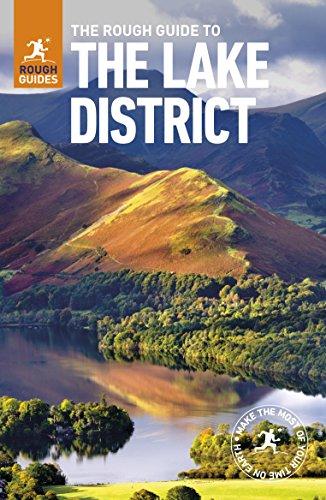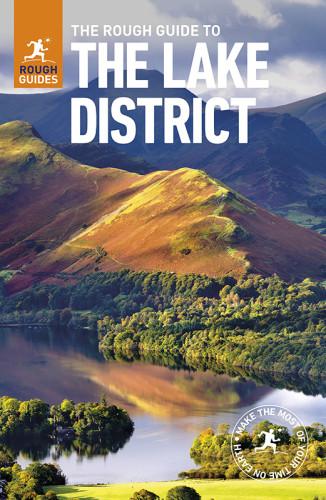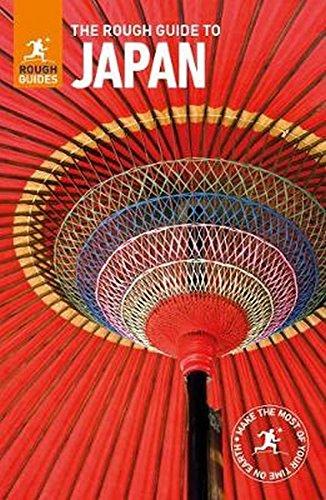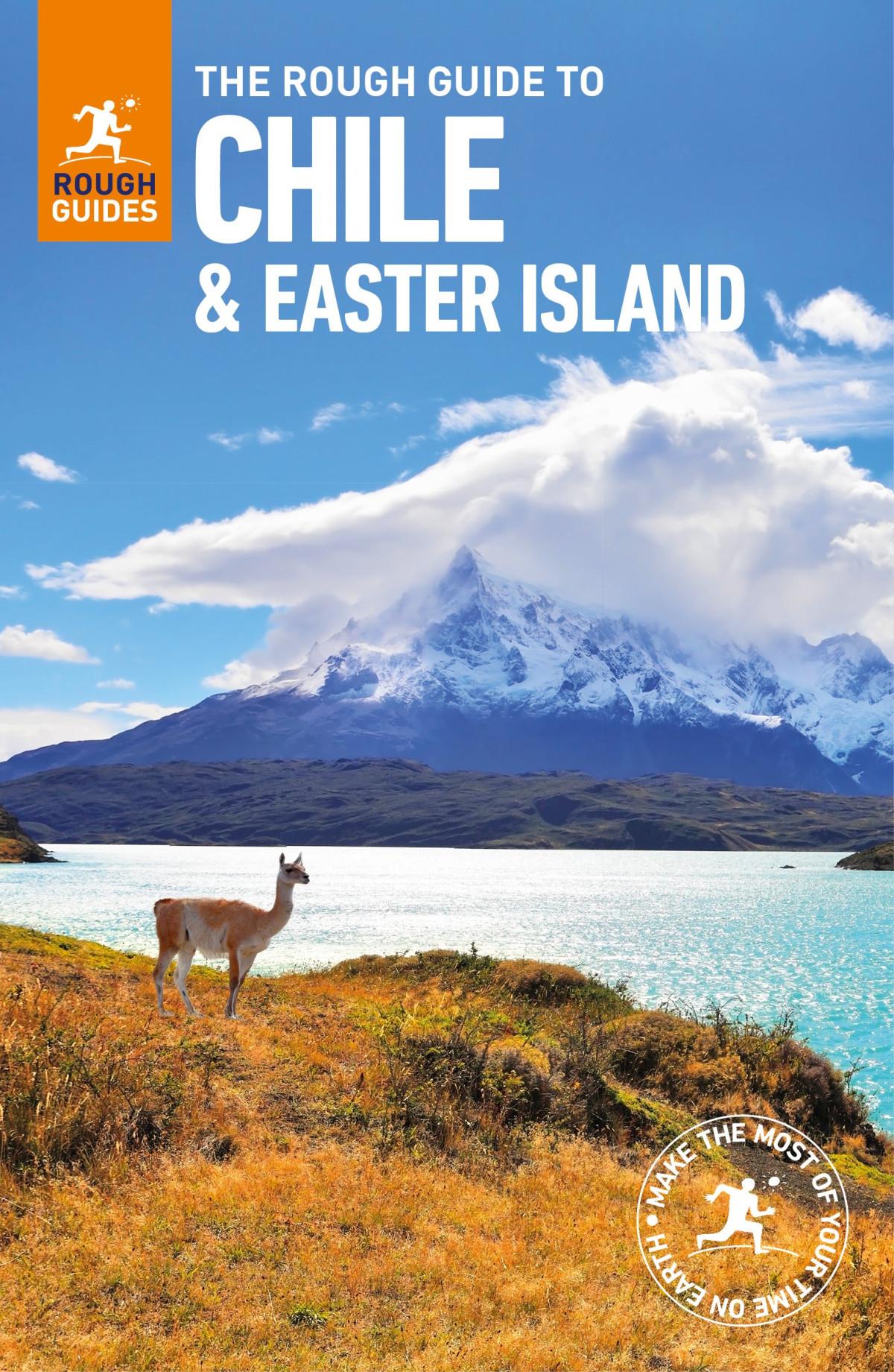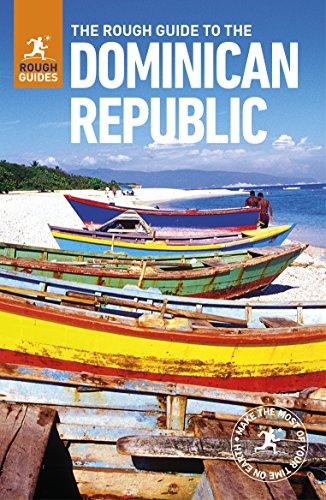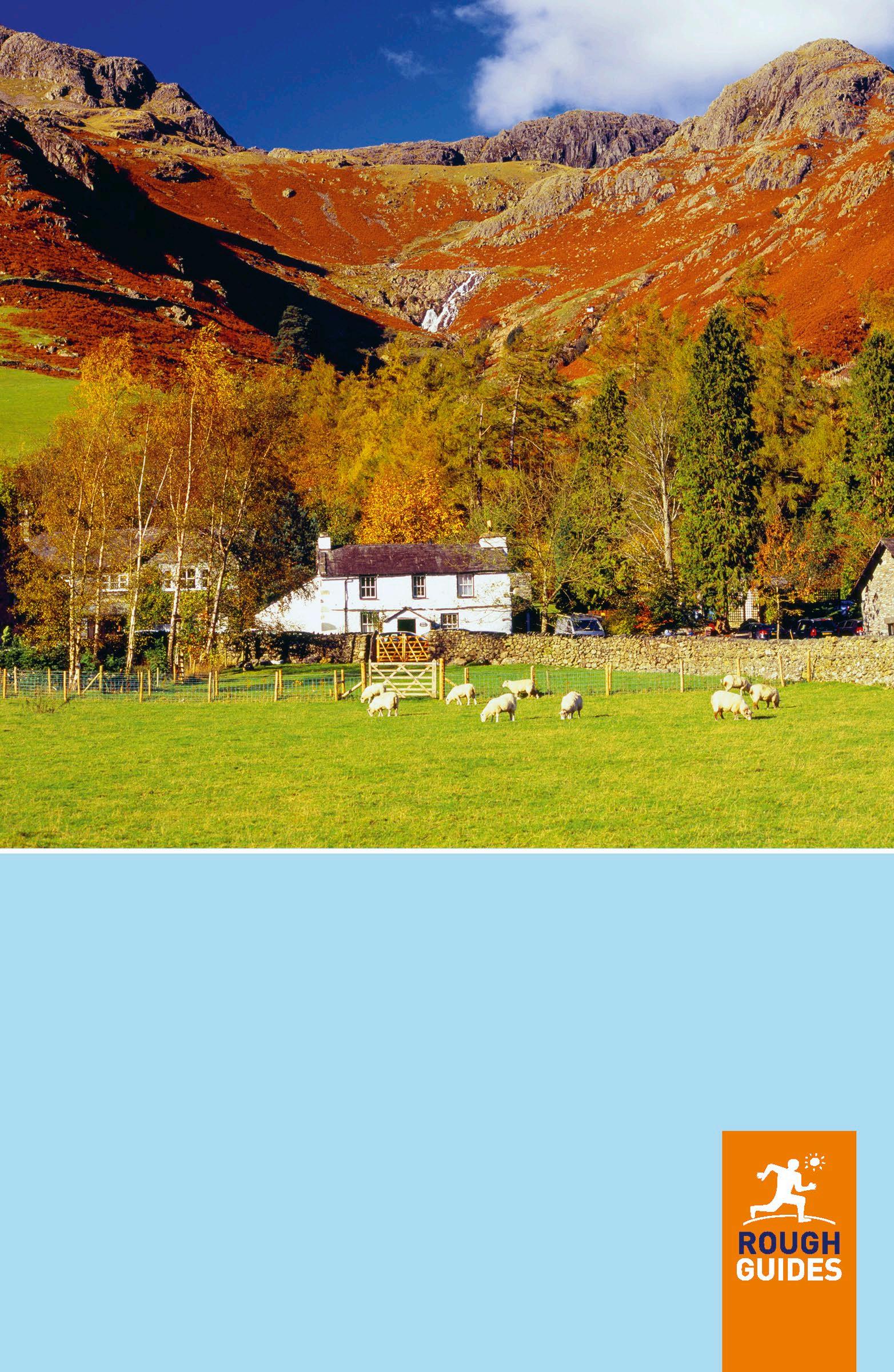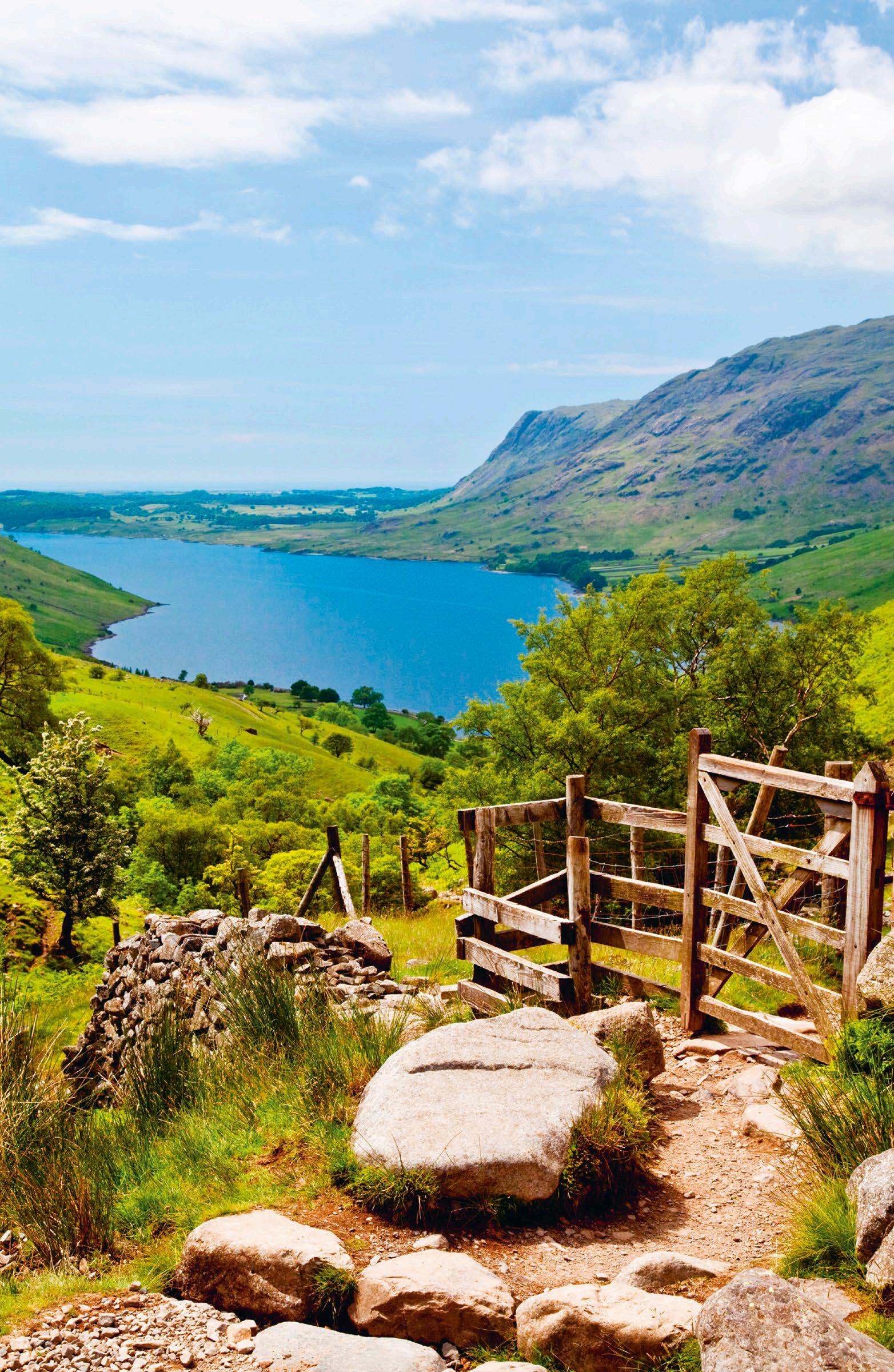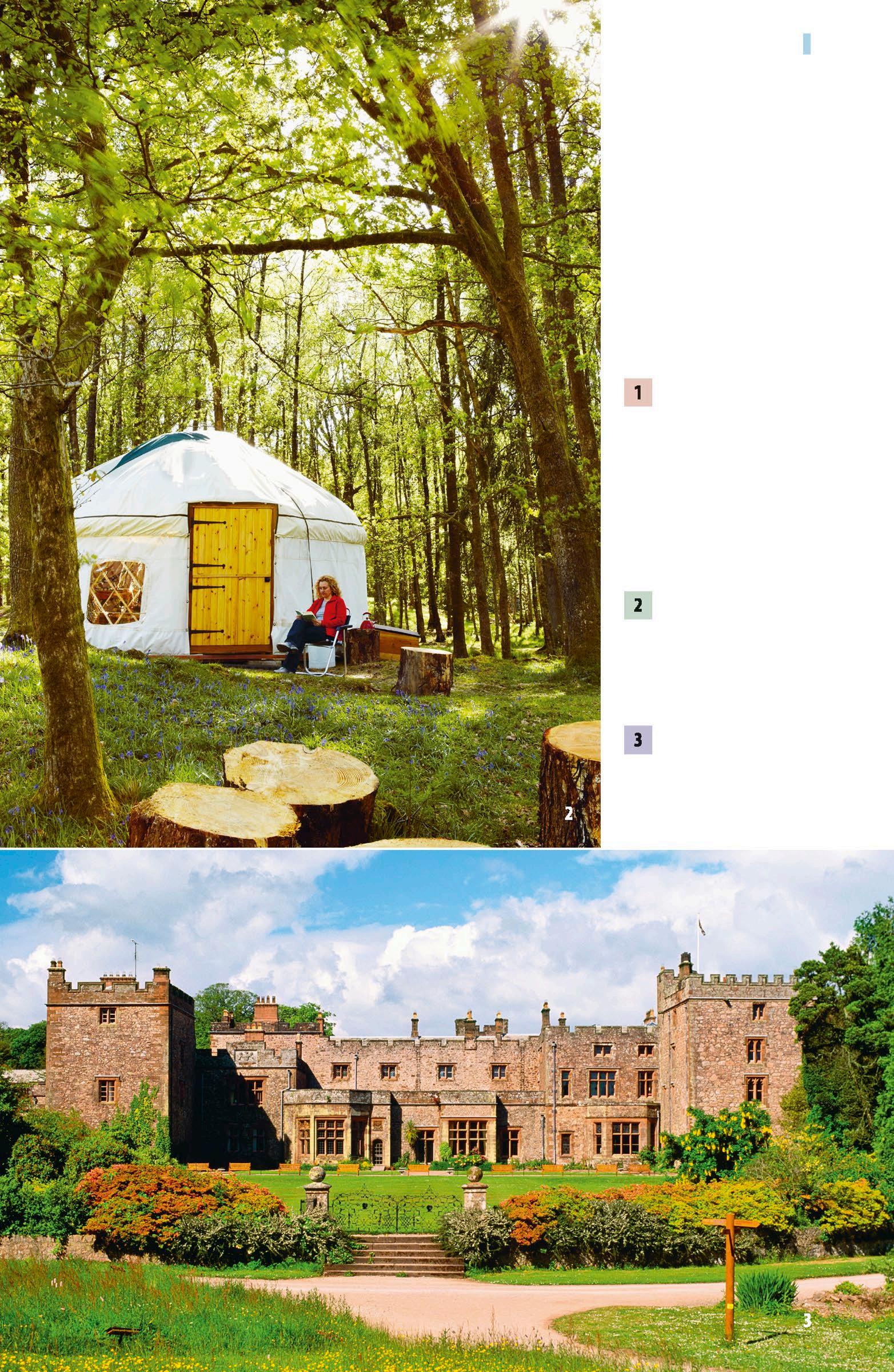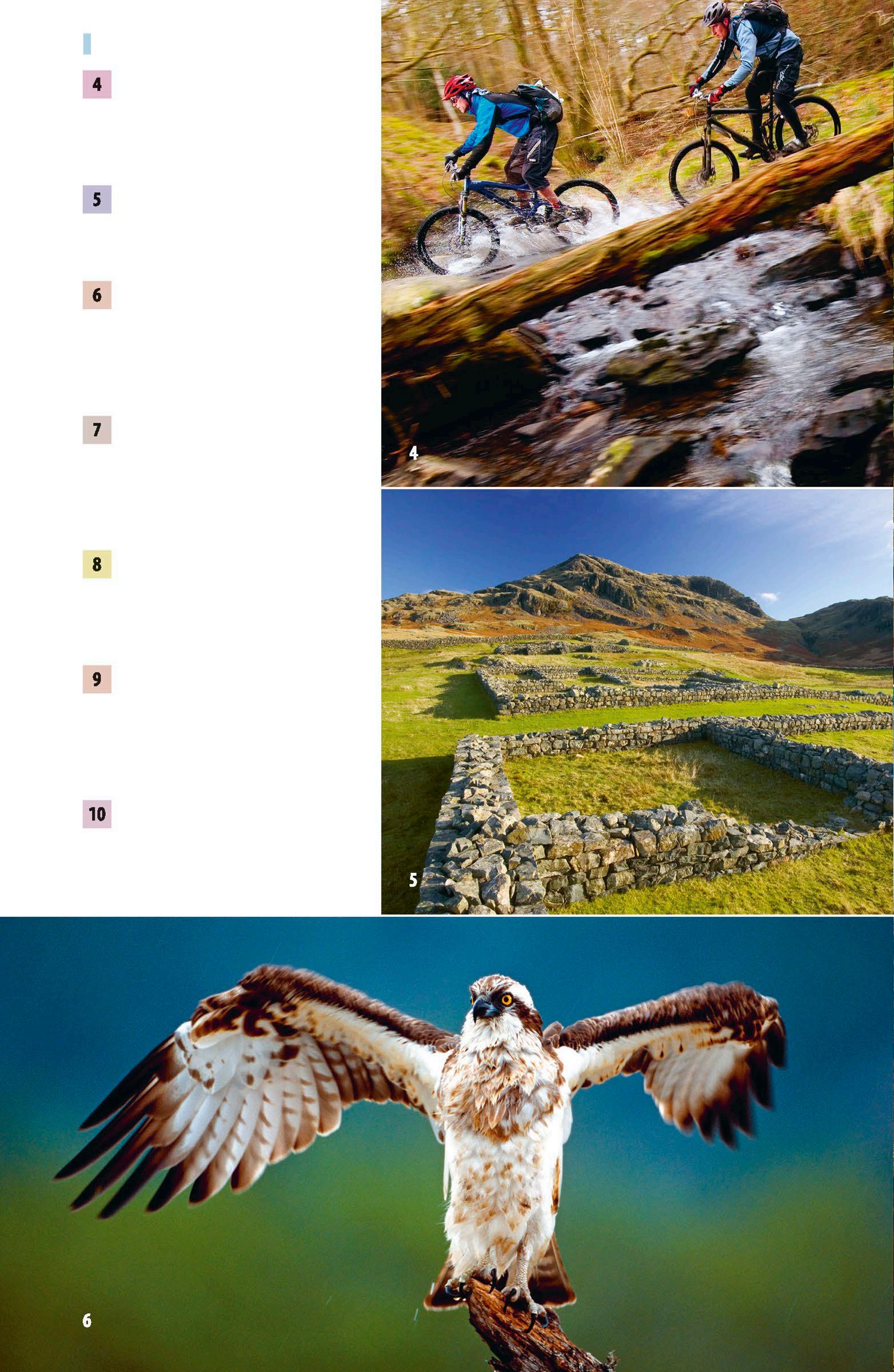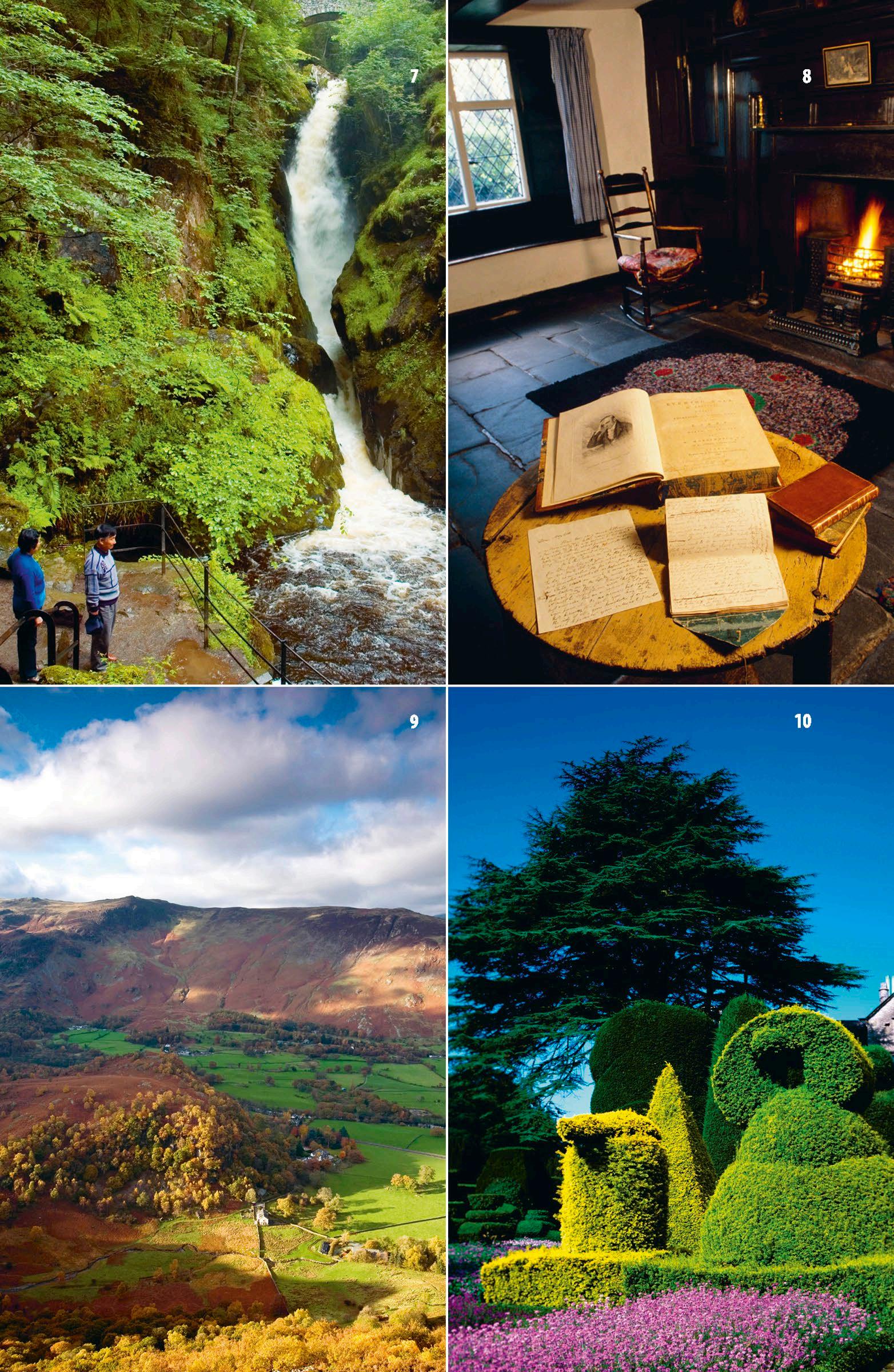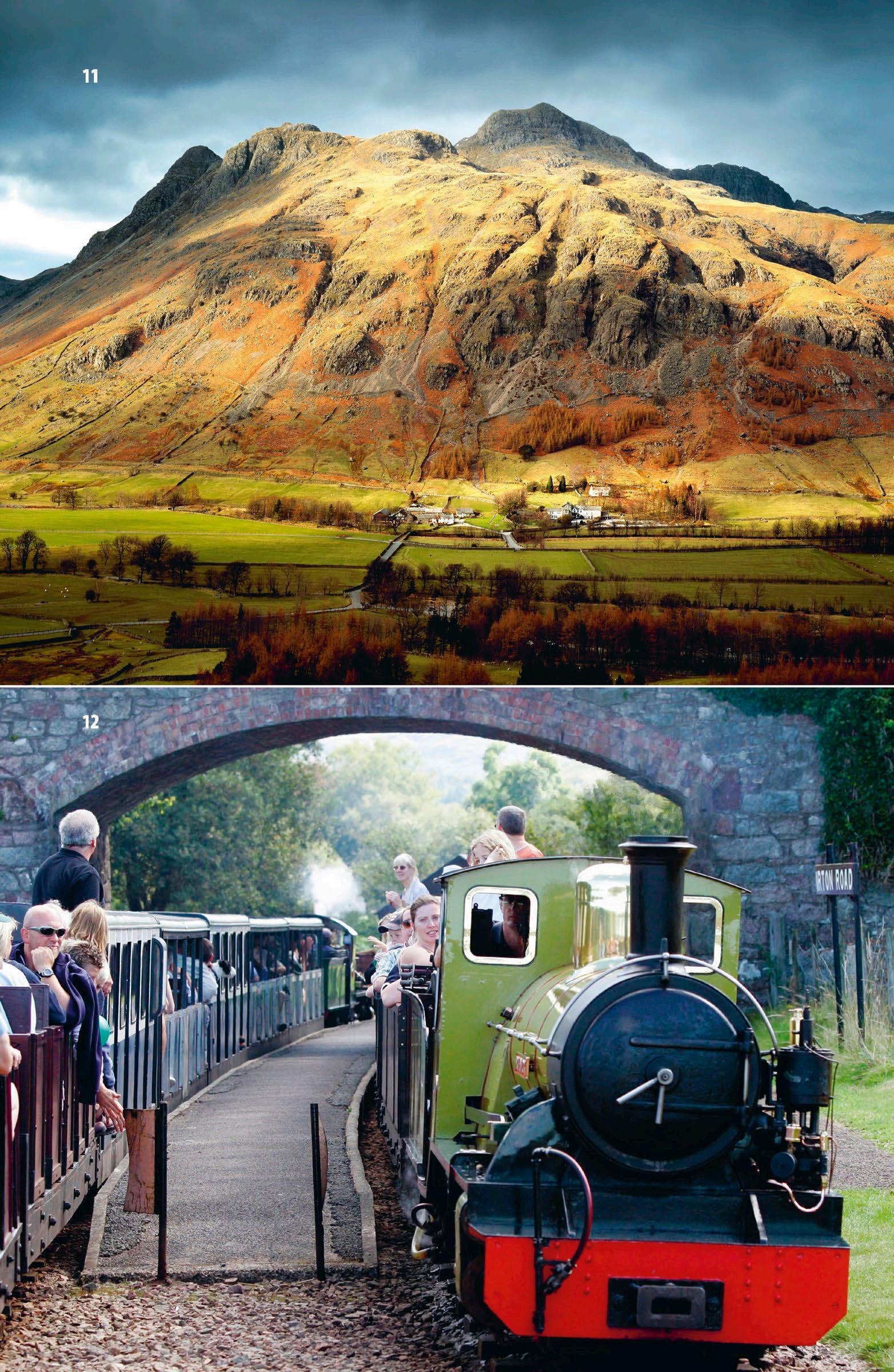The Lake District Introduction to
There’s nothing in England to match the splendour of the Lake District, a tight knot of romantic peaks, moors – and yes, lakes – up in England’s northwesternmost corner. For a nation reared on the tales of Beatrix Potter and Arthur Ransome, the pastoral images of a misty-eyed English past could hardly be more familiar: lush fields enclosed by dry-stone walls; warm, weatherbeaten and time-worn inns; shepherds gathering their flocks on green hillsides. Adventure-seekers, meanwhile, come to explore the country’s largest lakes and highest mountains, or to immerse themselves in full-on outdoor activities from mountain-biking to fell-walking and kayaking. Whatever attracts you to the country’s most famous, largest and most picturesque National Park, one visit won’t be enough.
While rural tradition and the great outdoors loom large on any Lake District trip, it’s not all sheepdog trials, hiking boots, timewarp pubs and flowery B&Bs. For such a small region (36 miles from east to west), there’s an astonishing number of glam places to stay and eat – from boutique hotels to organic tearooms, gastropubs to yurt-filled campsites – and you’re often closer to an artisan bakery or microbrewery than a tractor and a field full of sheep. Farming, in fact, accounts for just ten percent of the National Park’s working population, with up to to fifty percent of all jobs attributable in some way to tourism, rather than the more traditional occupations you might expect.
But wherever you stay, and whatever you do, the scenery certainly makes a play for your attention, whether it’s the glacial lakes and forested valleys or the steeply pitched mountains and their tumbling waterfalls. There’s nowhere else quite like it in Britain and even on the busiest of summer days it’s relatively easy to escape the crowds by climbing to the higher fells or exploring the more remote valleys.
The region’s literary connections are also justly famous – William Wordsworth and the Lake Poets feature, of course, but also many others, from John Ruskin to Norman
INTRODUCTION 4
ABOVE DERWENT WATER RIGHT BUTTERMERE
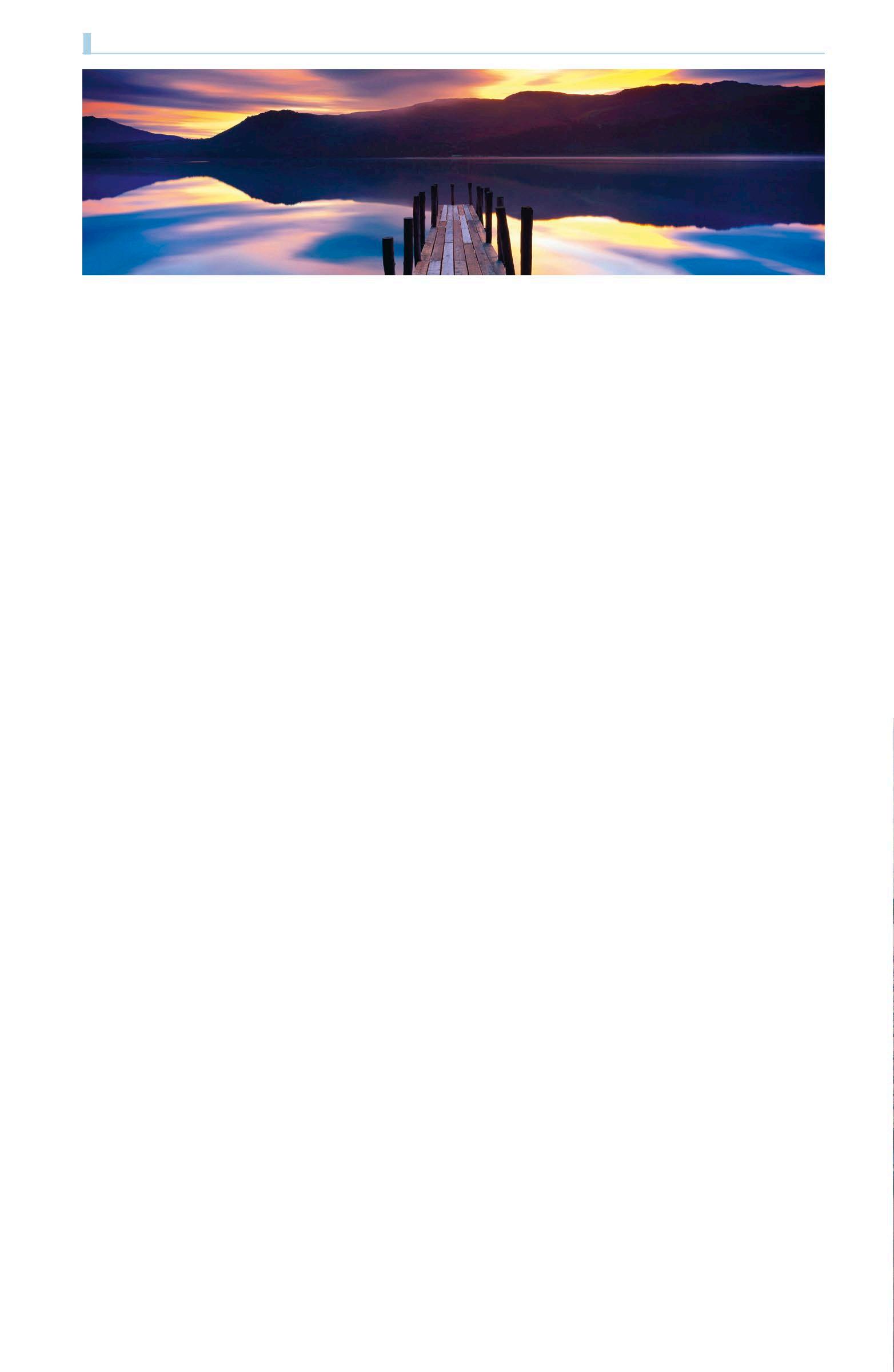
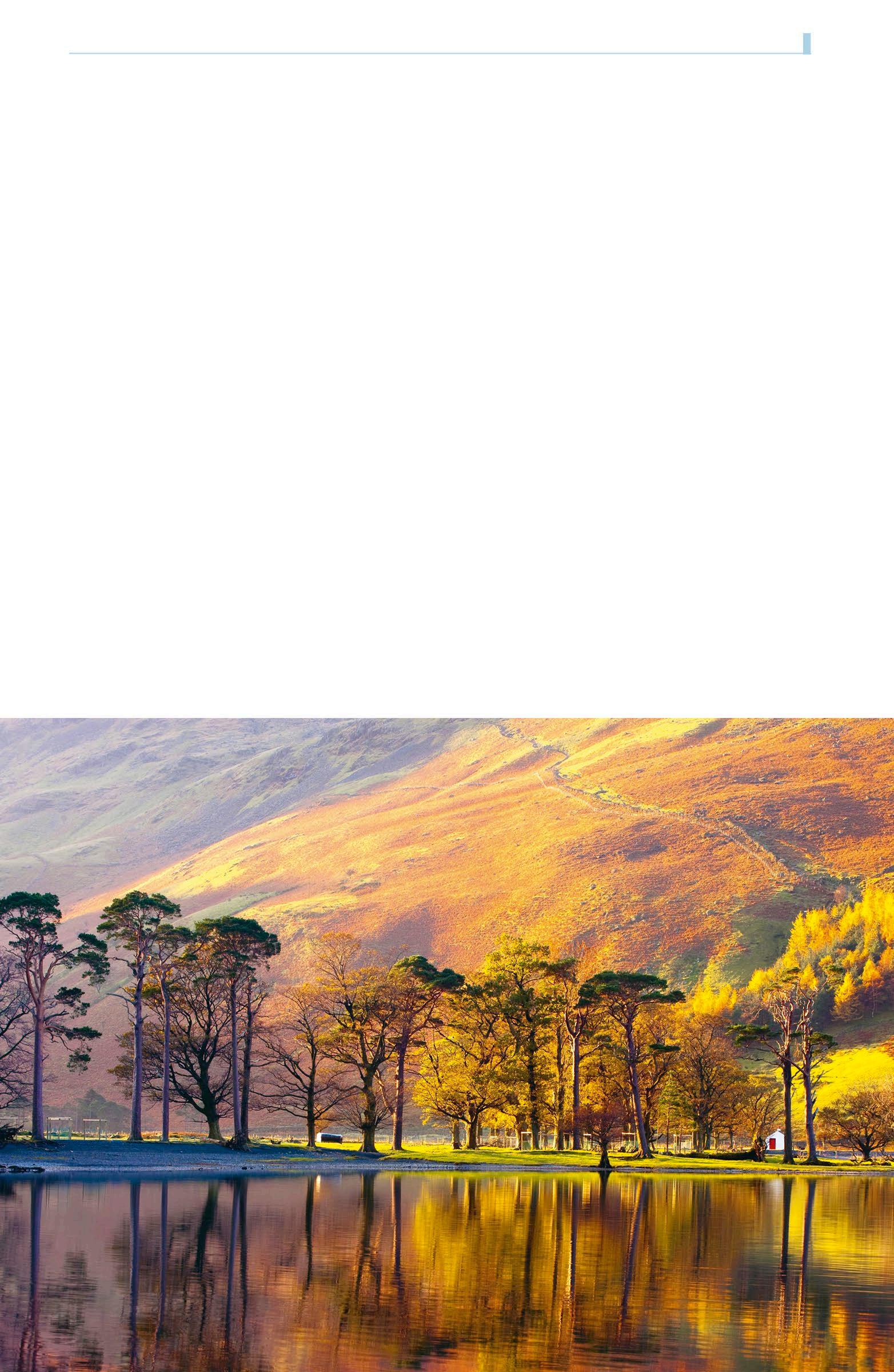
Nicholson, whose houses, haunts and places of inspiration form the backbone of many a lakeland literary trail. Perhaps surprisingly for such a rural area, a long industrial history manifests itself in scattered mining works, scarred quarry sites, surviving mills and a couple of old railway lines – Ravenglass to Eskdale, and Lakeside to Haverthwaite – now converted to tourist use.
In the end though, for all the renowned literary sites, local museums or big-ticket family-friendly attractions, many visitors take home a more personal memory of their trip. A lakeside stroll and a pint in front of a roaring fire; valley panoramas from scenic peaks such as Cat Bells; or a night’s star-gazing in spectacularly clear skies – they all guarantee that one day you’ll be back for more in England’s most ruggedly lovely holiday region.
Where to go
It’s easy to see a great deal of the Lake District in just a few days, even if you’re travelling by public transport or hiking from place to place. In fact, there’s a lot to be said for getting out of the car and seeing places under your own steam, whether it’s on foot, by bike or boat.
Windermere is the largest lake (10.5 miles long), featuring a cruise service which calls at all points north and south. The lake’s towns – Windermere, Bowness and, especially, Ambleside – are among the region’s busiest settlements and, given their
INTRODUCTION 5
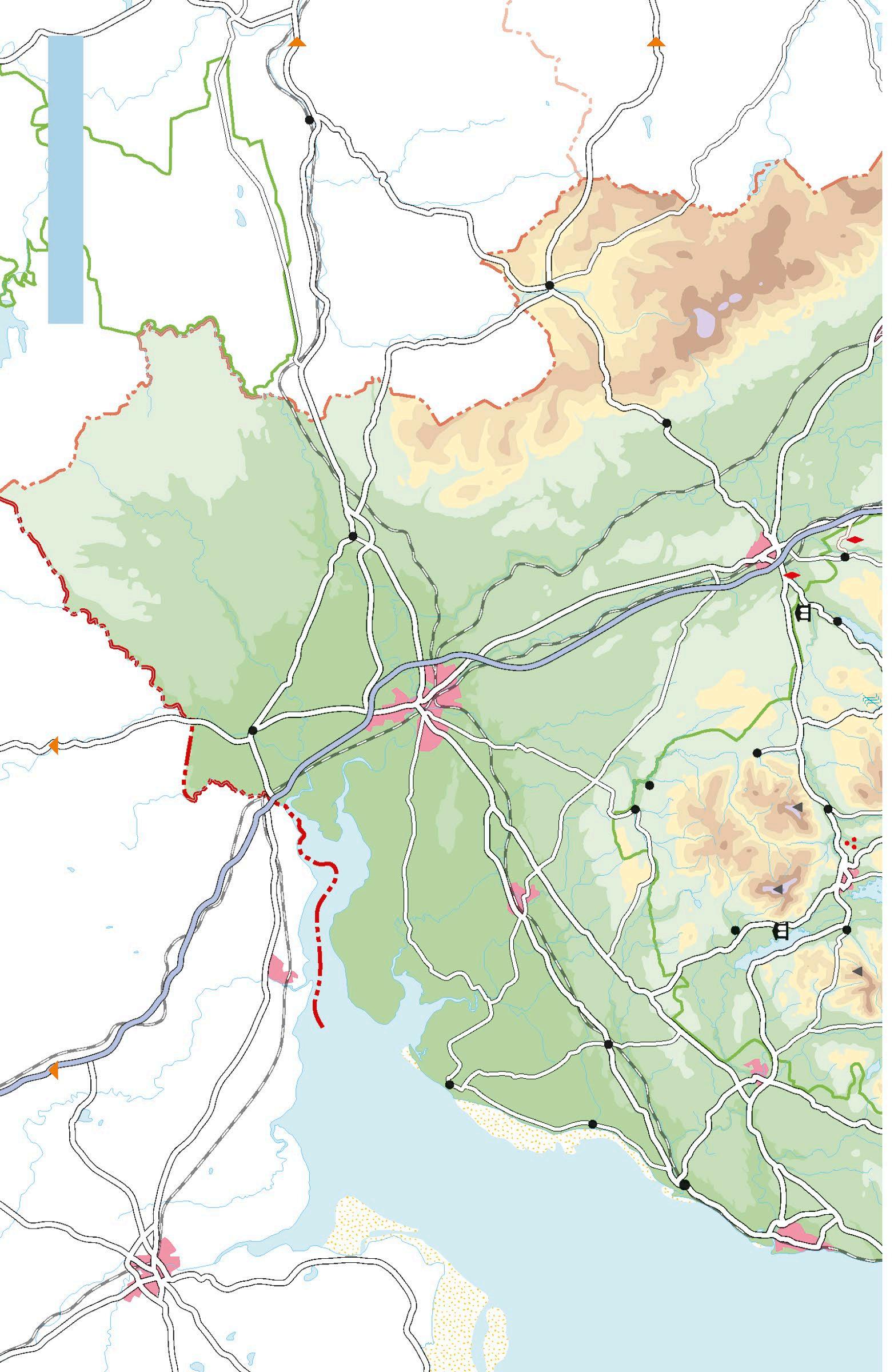
Pooley Bridge Askham Mungrisdale Threlkeld Alston Haydon Bridge Melmerby Brampton Longtown Caldbeck Braithewaite Bassenthwaite Allonby Aspatria Hesket Newmarket Silloth Keswick Cockermouth Maryport Wigton Workington Penrith Annan Dumfries SCOTLAND Carlisle A595 A595 A596 A5086 A69 A6 M6 A74 M M6 A689 A686 A66 A592 A686 Dalemain Mirehouse Castlerigg Lowther Castle & Gardens Rheged LAKE NORTHUMBERLAND NATIONAL PARK R i v e r D re tnew Bassenthwaite Lake RiverCocker RiverEden Solway Firth Grisdale Pike Blencathra Skiddaw WhinlatterPass CUMBRIA NORTHUMBERLANDCO. DURHAM Durham Newcastle upon Tyne Hawick Glasgow LAKE DISTRICT Howtown Loweswater Pooley Bridge Askham Mungrisdale Threlkeld Alston Haydon Bridge Melmerby Brampton Longtown Caldbeck Braithewaite Bassenthwaite Allonby Aspatria Hesket Newmarket Silloth Keswick Cockermouth Maryport Wigton Workington Penrith Annan Dumfries SCOTLAND Appleby-inCarlisle A595 A595 A596 A5086 A69 A6 M6 A74 M M6 A689 A686 A66 A592 A686 Dalemain Mirehouse Castlerigg Lowther Castle & Gardens Rheged LAKE NORTHUMBERLAND NATIONAL PARK R i v e r D re tnew Bassenthwaite Lake RiverCocker Loweswater Derwent RiverEden Aira Force Solway Firth Grisdale Pike Blencathra Skiddaw WhinlatterPass CUMBRIA NORTHUMBERLANDCO. DURHAM Durham Newcastle upon Tyne Hawick Glasgow LAKE DISTRICT


Milnthope Cark Cartmel Newby Bridge Oxenholme Bowness Millom Haverigg Whicham Silecroft Duddon Bridge Hawkshead Sawrey Coniston Ravenglass Boot Nether Wasdale Wasdale Head Gosforth Calder Bridge Elterwater Grasmere Tebay Orton Shap Troutbeck Staveley Kentmere Rydal Howtown Bampton Patterdale Seatoller Ennerdale Bridge Loweswater Buttermere Rosthwaite Glenridding Heysham Settle Kirkby Lonsdale Arnside Kendal Grange- over-Sands Ulverston Dalton-in-Furness Windermere Ambleside St Bees Egremont Cleator Moor Sedbergh Broughton- in-Furness Whitehaven Brough Morecambe Lancaster Barrow-in- Furness Appleby-in- Westmorland A66 M6 A685 A683 A684 A683 A65 A65 A683 M6 A6 M6 A6 A590 A5087 A595 A590 A593 A595 A591 A595 Furness Abbey Holker Hall Levens Hall Sizergh Castle Brantwood Swinside Stone Circle Muncaster Castle Blackwell Sellafield Ravenglass & Eskdale Railway Lakeside & Haverthwaite Railway DISTRICT NATIONAL PARK YORKSHIRE DALES NATIONAL PARK Crummock Water Loweswater Buttermere Ennerdale Water dlaCreviRre Derwent Water Wast Water IreviR r t iRksErev nodduDreviR Coniston Water LythValley Tarn Hows RiverKent Haweswater Ullswater RiverEden Winster Valley Esthwaite Water Thirlmere W i n d e r m e r e worroB - ad el Langdale Aira Force Morecambe Bay Harter Fell High Street Old Man of Coniston Langdale Pikes Bowfell Great Gable Scafell Pike Scafell Steeple Pillar Helvellyn Fairfield Black Combe Shap Fells Eskdale WrynosePass Hardknott Pass Kirkstone Pass Honister Pass Grizedale Forest IRISH SEA YORKSHIRE LANCASHIRE Feet 3000 2600 2200 1800 1400 1000 600 200 0 Scotch Corner (A1) Skipton & Leeds Manchester & Liverpool 10 0 miles N Milnthope Cark Cartmel Newby Bridge Oxenholme Bowness Millom Haverigg Whicham Silecroft Duddon Bridge Hawkshead Sawrey Coniston Ravenglass Boot Nether Wasdale Wasdale Head Gosforth Calder Bridge Elterwater Grasmere Tebay Orton Shap Troutbeck Staveley Kentmere Rydal Howtown Bampton Patterdale Seatoller Ennerdale Bridge Buttermere Rosthwaite Glenridding Heysham Settle Kirkby Lonsdale Arnside Kendal Grange- over-Sands Ulverston Dalton-in-Furness Windermere Ambleside St Bees Egremont Cleator Moor Sedbergh Broughton- in-Furness Whitehaven Brough Morecambe Lancaster Barrow-in- Furness Appleby-in- Westmorland A66 M6 A685 A683 A684 A683 A65 A65 A683 M6 A6 M6 A6 A590 A5087 A595 A590 A593 A595 A591 A595 Furness Abbey Holker Hall Levens Hall Sizergh Castle Brantwood Swinside Stone Circle Muncaster Castle Blackwell Sellafield Ravenglass & Eskdale Railway Lakeside & Haverthwaite Railway DISTRICT NATIONAL PARK YORKSHIRE DALES NATIONAL PARK Crummock Water Loweswater Buttermere Ennerdale Water dlaCreviRre Water Wast Water IreviR r t iRksErev nodduDreviR Coniston Water LythValley Tarn Hows RiverKent Haweswater Ullswater RiverEden Winster Valley Esthwaite Water Thirlmere W i n d e r m e r e worroB - ad el Langdale Aira Force Morecambe Bay Harter Fell High Street Old Man of Coniston Langdale Pikes Bowfell Great Gable Scafell Pike Scafell Steeple Pillar Helvellyn Fairfield Black Combe Shap Fells Eskdale WrynosePass Hardknott Pass Kirkstone Pass Honister Pass Grizedale Forest IRISH SEA YORKSHIRE LANCASHIRE Feet 3000 2600 2200 1800 1400 1000 600 200 0 Scotch Corner (A1) Skipton & Leeds Manchester & Liverpool 10 0 miles N

LAKELAND PLACE
NAMES AND TERMS
Many lakeland place names , geographical features and dialect words have origins that go back to Norse, Saxon or even Celtic times. The most common are appended to features you’ll see every time you stride out into the countryside – like “fell” (hill, mountain, or high common land), “mere” (lake), “holme” (island), “beck” (stream), “force” (waterfall) and “tarn” (small mountain lake).
With other names, it helps to know the derivation in order to figure out exactly what you’re looking at: such as place names ending in “-thwaite” (signifying a clearing), or those incorporating the words “ghyll” or “gill” (narrow ravine or mountain stream), “hause” (summit of a pass), “how” or “howe” (rounded hill), “pike” (peak), “raise” (summit of a ridge), “rake” (natural rock passage) or “wyke” (bay).
Farming language is deeply rooted in the past – words like “heaf” (grazing area), “garth” (enclosed land or field) or “lath” (barn) have ancient roots – and there is still an entire dialect counting system for keeping tabs on sheep (yan, tyan, tethera, or one, two, three …), not to mention scores of other local words for describing traditional skills and pastimes, from basket-weaving to wrestling.
choice of accommodation, cafés, restaurants and pubs, they make obvious bases. Even if they don’t plan to stay there, most people at least pass by Windermere on the way to Grasmere and the famous Wordsworth houses, or to impossibly pretty Hawkshead and Beatrix Potter’s house at nearby Hill Top.
Coniston Water boasts the Brantwood home of John Ruskin, plus cruises on the lake’s idiosyncratic wooden launches and steam yacht. Away from the literary trail, there are renowned hikes, peaks and tarns in central Langdale – and, arguably, the finest hikers’ inn in Britain (the Old Dungeon Ghyll) from which to explore them.
The scenery is even more dramatic in the north, where four peaks top out at over 3000ft –including England’s highest mountain, Scafell Pike (3210ft) – while the quite different lakes of Derwent Water and Ullswater provide superb backdrops for a day’s cruising and walking.
Keswick, the main town in the north, is the one major lakeland settlement with real year-round character, and it makes a handy base for exploring – from delightful Borrowdale, a valley for which the word picturesque might have been invented, to Bassenthwaite and its ospreys, nature reserves and animal park.
On the western side of the National Park, gentle Buttermere is perhaps the best-known destination, while awesome Wast Water (incidentally, England’s deepest lake) and remote Ennerdale Water lie further off the beaten track. Keep heading west and you find the only part of the Cumbrian coast that lies within the National Park. This stretches twenty miles south from Ravenglass, an undistinguished village with a Roman past, which provides a bucolic route into the heart of dramatic Eskdale via the charming Ravenglass & Eskdale Railway.
Outside the somewhat arbitrary National Park boundaries, most visitors make time for the southern gateway town of Kendal, the revitalized Georgian port of Whitehaven and the peripheral historic market towns of Ulverston, Penrith and Cockermouth, the last also famous as the birthplace of Wordsworth. Foodies meanwhile increasingly make their way to the highly attractive village of Cartmel, which is rapidly becoming a something of a boutique getaway.
INTRODUCTION 8

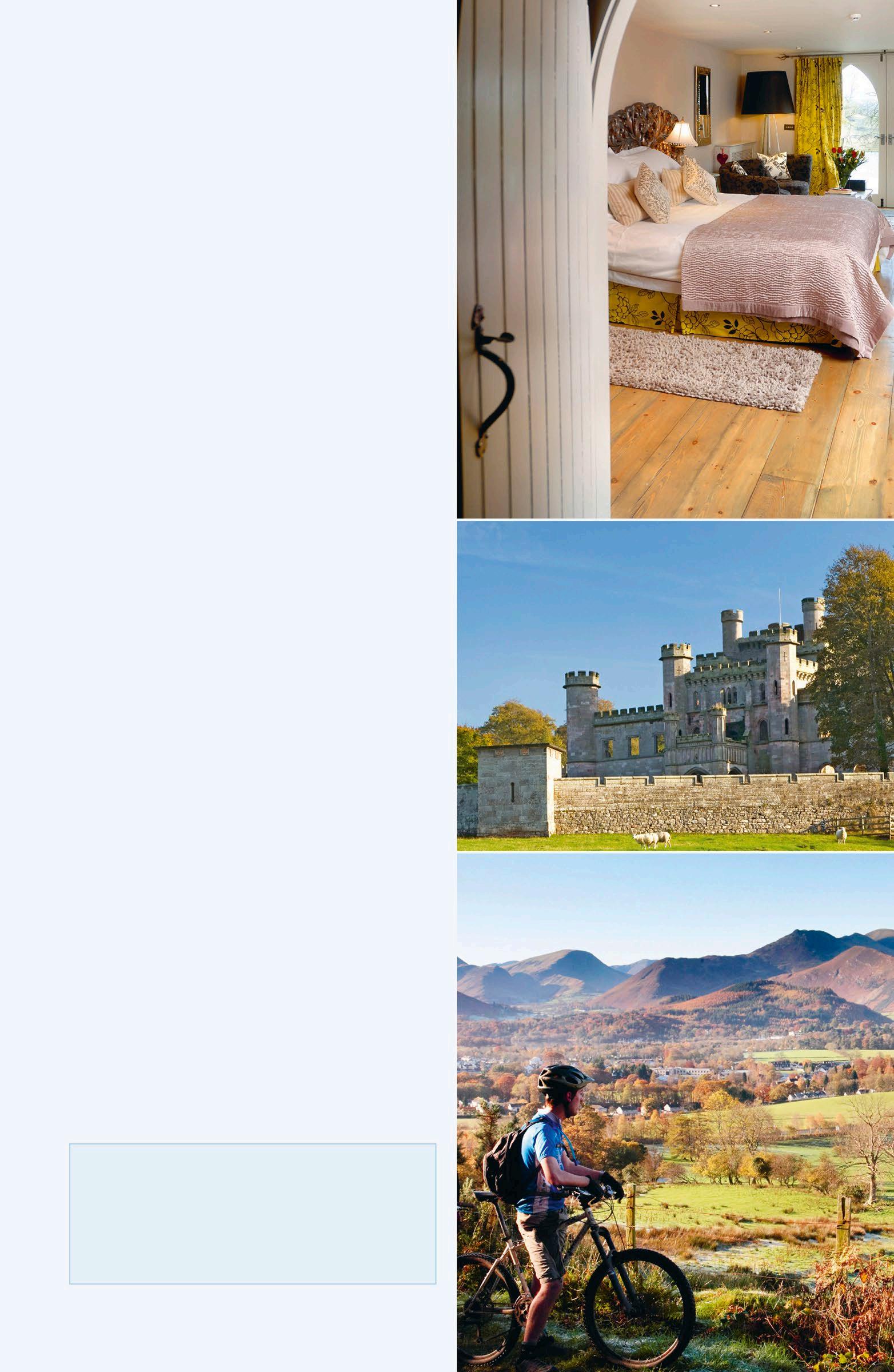
Author picks
Author Jules Brown has visited every corner of the Lake District over many years to bring you some unique travel experiences. Here are some of his own personal favourites.
Romantic weekend Lounge in luxury at the cunningly named Randy Pike, a former gentleman’s hunting lodge converted into a gorgeous boutique B&B (p.77).
Spectacular views Latrigg (p.151) for a quick dash and a lake vista; Kentmere Horseshoe (p.81) for a long walk with sweeping panoramas.
A walk, a fire and a pint Toddle around Loweswater and fall gratefully into the Kirkstile Inn (p.196).
King for a day Muncaster (p.182) and Lowther (p.216) offer very different castle experiences, but for noble life in a nutshell Wray Castle (p.72) gets the nod.
Off-road biking What a backdrop for a bike ride, and what a choice of experiences – first-timers shouldn’t miss the exhilarating Eskdale Trail (p.184).
Glamping When it comes to camping the Lakes can’t be beat, from woodland pods at Grizedale Campsite (p.134) to the mountain-view yurts at Great Langdale (p.108).
Quirky museum You want to see lion’s teeth and bang some musical stones? You want Keswick Museum (p.144).
Adrenaline rush When hiking and biking simply won’t cut it, accept the challenge of Honister’s Via Ferrata (p.163).
Gourmet picnic Artisan bread from More? (p.83), farmhouse cheese from Cartmel Cheeses (p.234), organic fruit and veg from Low Sizergh Barn (p.230) and a takeaway gourmet pizza to share from the Woolpack Inn (p.188).
Wild swimming It’s against the spirit of the thing to make a specific recommendation, but pick a tarn and take the plunge – you may just discover your new best outdoor hobby.
Our author recommendations don’t end here. We’ve flagged up our favourite places – a perfectly sited hotel, an atmospheric café, a special restaurant – throughout the Guide, highlighted with the ★ symbol.
FROM TOP RANDY PIKE; LOWTHER CASTLE; VIEW TOWARDS THE DERWENT FELLS FROM THE BASE OF LATRIGG

SENSATIONAL SAUSAGES
The humble breakfast sausage is hardly so humble in the Lake District, where the traditional highly spiced, spiral-shaped Cumberland sausage is king. Its origins are obscure, though some trace its ancestry to the arrival of German miners in the Lake District in the sixteenth century. Whatever the truth, Cumbrian butchers zealously guard their secret recipes for the perfect blend of pork, herbs and spices, and the matter is taken so seriously that there’s a celebratory Sausage Day every July. Meanwhile, in 2011, following years of campaigning by the Cumberland Sausage Association and others, the traditional Cumberland sausage was finally awarded the same protected status as Parma ham, champagne, Stilton cheese and Melton Mowbray pork pies; if you want to guarantee your breakfast banger has been made in Cumbria to a strictly traditional recipe, look for the European PGI mark.
When to go
It rarely pays to second-guess the weather in the Lake District. You can get varying conditions – or even several seasons – on the same day sometimes. But there are a few generalizations that can be made, as well as some observations about the best time of year for a trip to England’s northwestern corner.
High summer may be the warmest season – usually – but it isn’t the ideal time to visit the Lakes. July and August can see accommodation (and the roads) stretched to capacity as the bulk of the annual visitors descend. If you’re thinking of swimming in the lakes, it’s worth knowing that late August and September see the waters at their warmest, as they’ve had time to soak up the summer sun. To be honest, though, you’ll barely notice the difference: the inland waters are pretty cold, at best, year-round.
Other busy periods include Easter week, the few days around New Year and school half-term holidays (February and October). Fewer people visit the Lakes in the late autumn, winter and early spring, so if you’re looking for relative peace and quiet, these are the seasons to choose. Many of the indoor sights and attractions remain open year-round, so you shouldn’t be unduly inconvenienced, and while some hotels, guesthouses and campsites are closed, those that do stay open tend to offer reduced rates.
Spring usually arrives a little later than in the south of England, though in mild seasons you sometimes get the famous daffodils flowering as early as February. Mostly, though, before May you might get bright, blue skies, but you can also expect chilly mornings, overnight frosts and cold conditions (snow can linger on north-facing slopes as late as June). December has the shortest and rainiest days; November and January aren’t much better.
INTRODUCTION 10 FROM TOP LAKE DISTRICT HIKERS; MORRIS DANCERS OUTSIDE KINGS ARMS PUB, HAWKSHEAD
AVERAGE DAILY TEMPERATURES AND RAINFALL Jan Feb Mar Apr May Jun Jul Aug Sep Oct Nov Dec Max/min (ºC) 4/1 5/1 8/1 11/2 14/5 16/7 19/10 18/9 15/7 12/5 8/2 6/0 Max/min (ºF) 39/34 41/34 46/34 52/36 57/41 61/45 66/50 65/48 59/45 54/41 46/36 43/32 Rainfall (mm) 230 200 135 91 90 83 70 98 110 180 164 206

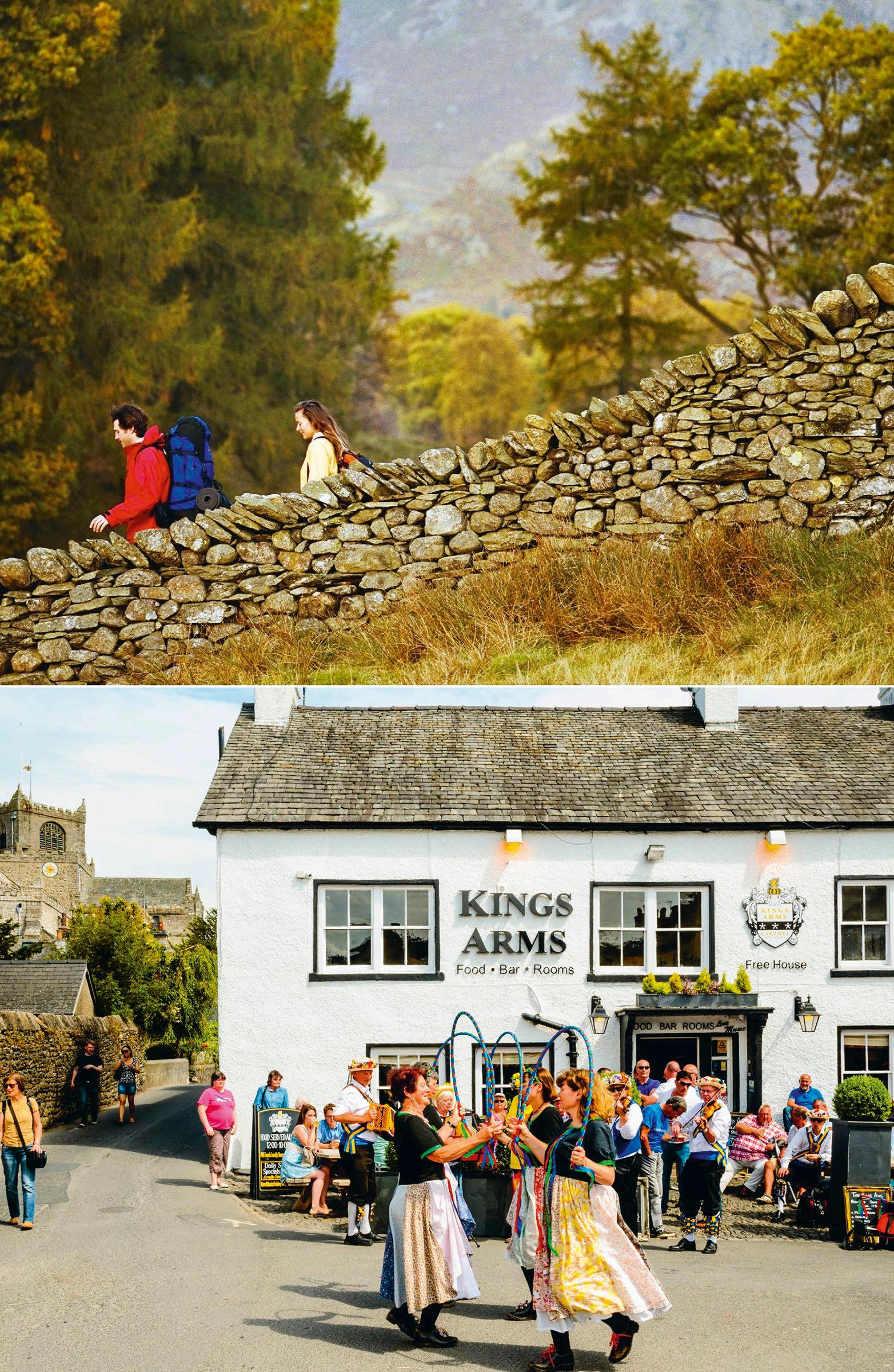
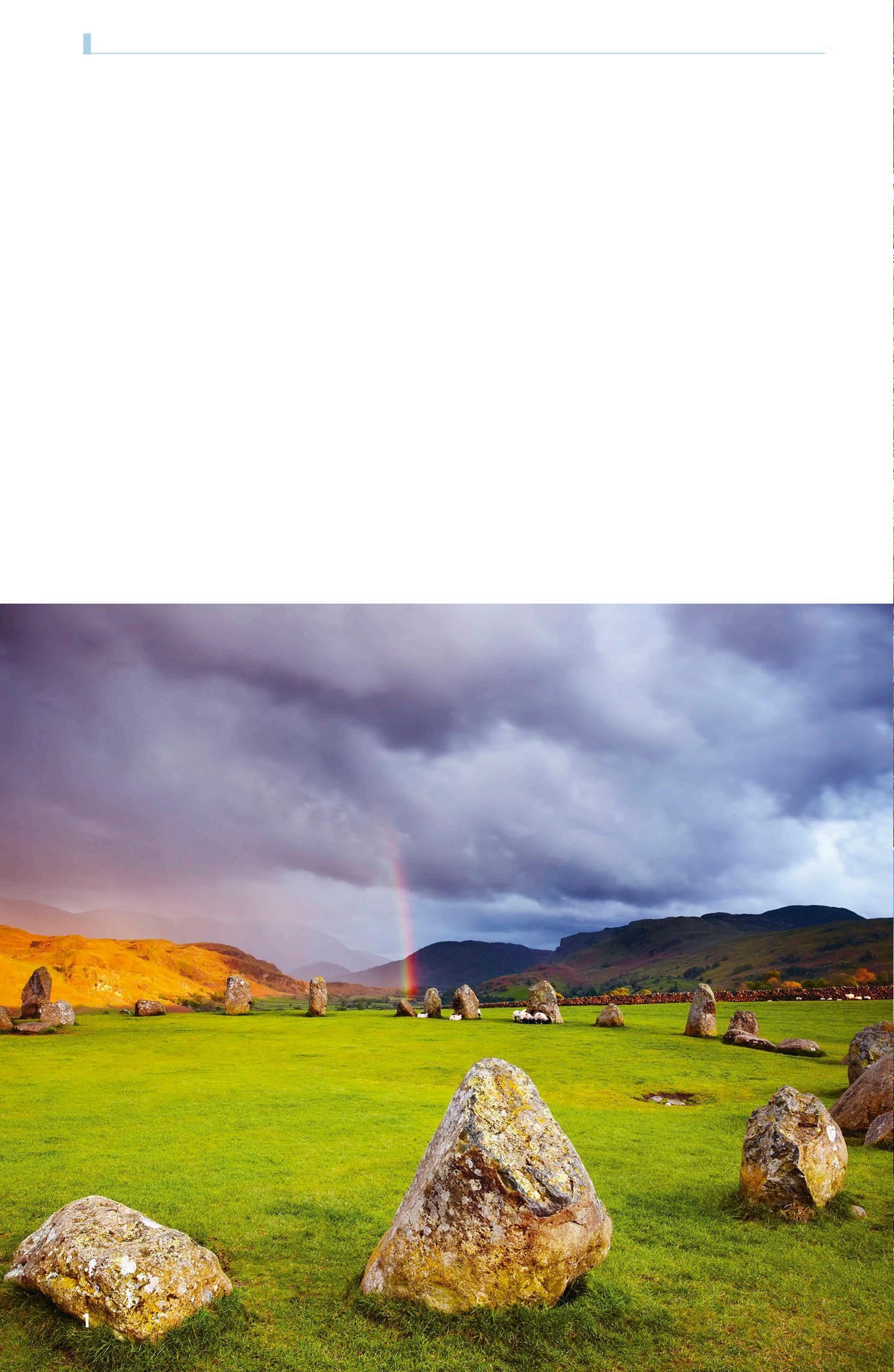
Itineraries
The Lake District might only be a small region but it packs an awful lot in, not least England’s highest mountain and the country’s deepest and longest lakes. A tour of the major highlights could be done in a week, but ten days is better. Come for the weekend and you’ll still be able to sample some of the region’s most alluring tastes and attractions.
LAKES GRAND TOUR
1 Windermere A cruise on Windermere up to the main National Park Visitor Centre at Brockhole starts you off on the right foot. See p.58
2 Grasmere The poet’s village grave and his famous Dove Cottage are obvious lures, though Wordsworth himself was happiest in the outlying family home of Rydal Mount. See p.86
3 Keswick and Skiddaw From Keswick, the main resort town in the north, you can conquer Skiddaw, easiest of the Lake District’s famed 3000ft mountains. See p.151
4 Borrowdale South of Keswick lies the Lakes’ most handsome valley, with its Derwent Water vistas, isolated farming villages and hardcore hiking trailheads. See p.157
5 Buttermere Cross Honister Pass – where mountain adventures await at Honister Slate Mine– and descend to Buttermere, the most spectacularly sited of the western lakes. See p.197
6 Cumbrian coast Top attraction is the narrow-gauge Ravenglass & Eskdale Railway, which steams from the Cumbrian coast into the heart of the western fells. See p.182
7 Eskdale The glorious Eskdale valley is overlooked by a stupendously sited Roman fort, after which comes a dramatic, zigzag drive over the notorious Hardknott Pass. See p.185

8 Coniston Water Inspiration for Arthur Ransome’s Swallows and Amazons – take a cruise on the magnificent Steam Yacht Gondola to evoke memories of bygone days. See p.118
9 Holker Hall Top stately home is a tough call, but for wonderful gardens, and a tearoom and food hall to boot, our vote is for Holker. See p.223
LITERARY LAKES
1 Wordsworth House See where it all began – birthplace and family home of William Wordsworth, in the agreeable Georgian town of Cockermouth. See p.246
2 Aira Force Away from Wordsworth’s houses are more gentle reminders of his inspired genius – like the dancing Gowbarrow daffodils near Ullswater’s Aira Force waterfall. See p.206
3 Orrest Head The very first lakeland hill climbed by fell-walker extraordinaire, Alfred Wainwright; chances are you’ll have one of his walking guides with you. See p.51
4 Armitt Library and Museum The best place to investigate the contributions of an eclectic set of writers and artists to Lake District life, from Beatrix Potter to Kurt Schwitters. See p.70
5 Allan Bank Complement Grasmere’s famous Wordsworth houses with a visit to the National Trust’s fascinating Allan Bank, a short-lived home to the poet that was unseen by the public for two hundred years. See p.92
ITINERARIES 18
ABOVE FROM LEFT LAKELAND INN; VIEW OF WINDERMERE FROM ORREST HEAD

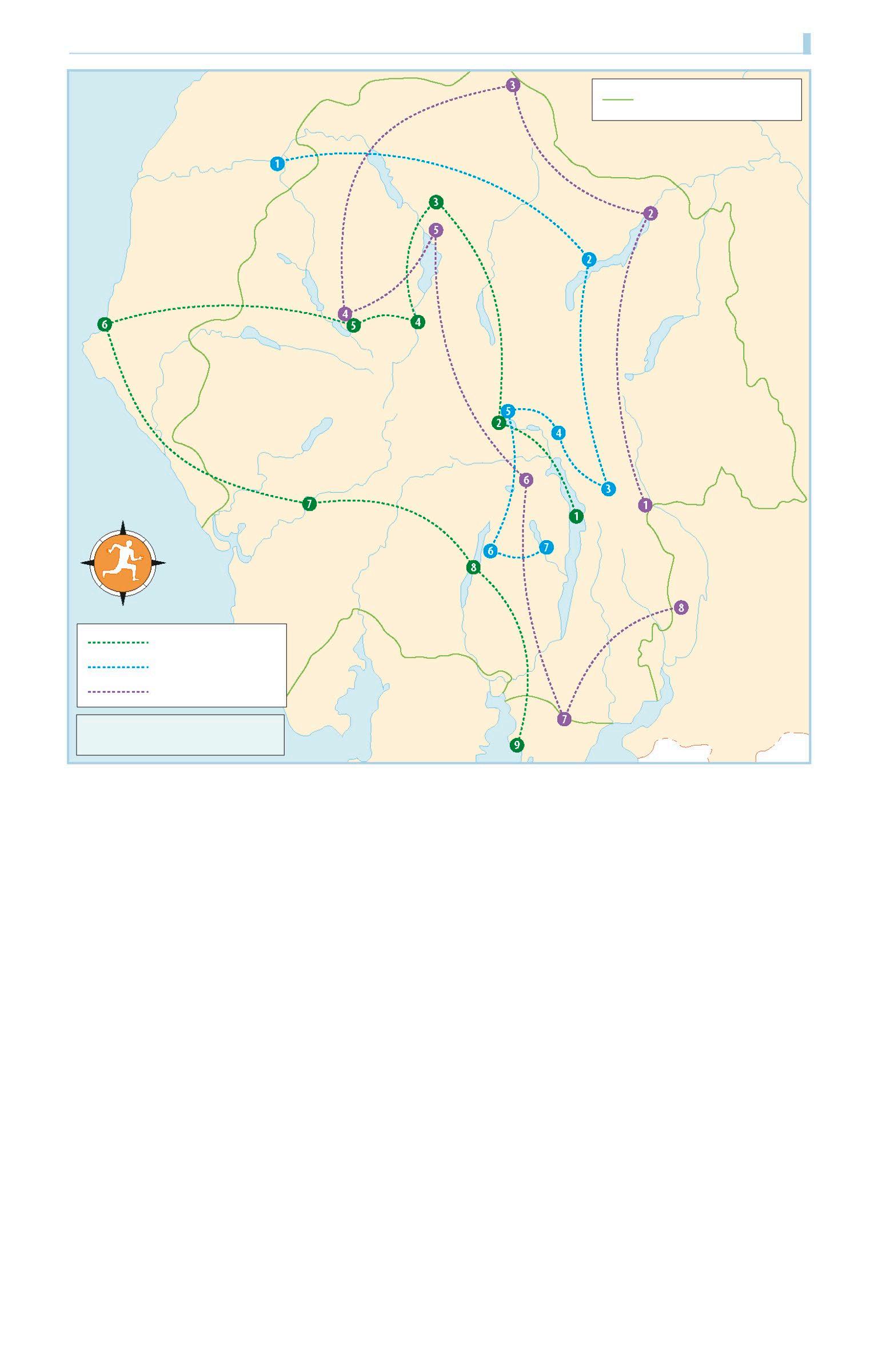
6 Brantwood John Ruskin built a beautiful house above the shores of Coniston Water – come by boat for a complete experience. See p.123
7 Hill Top Beatrix Potter’s favourite Lakeland spots feature in her timeless children’s stories – not least the farmhouse where she wrote many of her books. See p.130
TASTING THE LAKES
1 Staveley The craft-foodie businesses at Mill Yard range from artisan bakery to microbrewery and beer hall. See p.81
2 Pooley Bridge Farmers’ Market A pretty village location for a spring and summer farmers’ market showcasing local growers and producers. See p.212
3 Old Crown The out-of-the-way village of Hesket Newmarket has a landmark pub in the Old Crown, the first cooperatively owned pub in the UK – championed and visited by Prince Charles, no less. See p.173
4 Syke Farm Farmhouse tearoom at glorious Buttermere, with ice cream made from the milk of their own Ayrshire cows – that’s food inches, not miles. See p.199
5 Keswick Market Hit Keswick on Thursday or Saturday, when Market Place fills with stalls offering everything from artisan cheese to home-made curry. See p.144
6 Drunken Duck Inn The Hawkshead country inn that sets the local benchmark, with boutique rooms, gourmet food and an award-winning brewery out back. See p.128
7 Cartmel Medieval village that’s centre of the epicurean scene, from Michelin-starred L’Enclume restaurant to the world’s best sticky toffee pudding direct from the village shop. See p.232
8 Low Sizergh Barn An organic dairy farm outside Kendal that lets you get up close and personal with the herd – the tearoom overlooks the milking parlour and the floor show starts around 3.30pm every afternoon. See p.230
ITINERARIES 19
LAKES GRAND TOUR LITERARY LAKES TASTING THE LAKES N Lake District National Park boundary CUMBRIA 10 0 miles

Basics 21 Getting there 22 Getting around 25 Accommodation 29 Food and drink 32 Festivals, shows and events 36 Children and families 37 Walking, climbing and the mountains 40 Boating, watersports and swimming 41 Organized holidays, courses and activities 42 Travel essentials
POSTBOX NEAR GLENRIDDING


Getting there
The Lake District is in the county of Cumbria, in the northwest of England, eighty miles north of Manchester and 270 miles from London. The M6 motorway gets you within a few miles’ drive of the eastern side of the region, while public transport links are good, with trains or buses providing reasonably direct services from most major British cities (and from Manchester Airport). The main points of access are Lancaster, Kendal and Windermere to the south, and Penrith and Carlisle to the north. this section tells you how to reach the Lake District by bus, train or car, and gives all the contact details you’ll need for planning routes and booking tickets. touring around the Lakes by either public transport or car is covered in “Getting around” (see p.22).
Large-scale package-tour operators tend to concentrate on whirlwind trips through the region, bussing passengers in to see the famous lakes and literary sites. Generally speaking, you can do much better on your own – either using public transport or booking local tours. But for outdoor activities or pastime-based holidays – from cycle touring to art appreciation – we’ve picked out some of the more interesting options in the “Walking, climbing and the mountains” (see p.37) and “Organized holidays, courses and outdoor activities” sections (see p.41).
For more guidance on holidaying in the Lake District – including full transport details –contact Cumbria Tourism (T 01539 822222, W golakes.co.uk).
By train
the main train access is via the west-coast main-line service between London and
Glasgow. For the Lake District, you change either at Lancaster or Oxenholme for the branch-line service to Kendal (3min from Oxenholme) and Windermere (20min). the only other places in the region directly accessible by train are Penrith (also on the west-coast main line) and Carlisle (west-coast main line, plus connections from newcastle upon tyne). there are also direct services from Manchester to Kendal and Windermere; and from Manchester, Preston and Lancaster along the Cumbrian Coast line to Ulverston, Barrow-in-Furness, r avenglass, Whitehaven and Carlisle, providing a leisurely approach to the western Lakes. Various train operators provide these services: check National Rail Enquiries (W nationalrail.co.uk) for timetable, route and service information – the website has a journey planner and links to ticket-sale sites.
From London (euston Station) there are up to ten departures a day to Windermere; the trip usually take around three hours and thirty minutes. there are some very good deals if you book in advance (the earlier the better), with one-way fares starting at £23.50, or around £45 return. if you buy your ticket on the day, or travel at more popular times, expect to pay more like £90 one way (£103 return), and a lot more if you intend to travel on a Friday or during peak commuter hours. to reach Keswick and the northern Lakes, either take the train from Oxenholme to Windermere and continue from there by bus or stay on the main-line service to Penrith or Carlisle, from where buses also run to Keswick.
From Manchester, the quickest trains to Windermere take an hour and forty minutes (advance one-way fares from £8.50, otherwise from £12.40). note that some services from or via Manchester might require a change of trains either at Lancaster or at Oxenholme, the station for the Lakes on the west-coast main line. Coming from Yorkshire, a
GETTING TO THE LAKE DISTRICT FROM OVERSEAS
From Manchester Airport, northern england’s major airport, there are direct train services to Kendal and Windermere. travelling from ireland by ferry, the most logical port to use is Liverpool (sailings from Belfast and Dublin), from where it’s an easy train ride to Manchester and on to the Lakes. Using the Belfast service to Stranraer in Scotland, you’ll need to travel first by train to Glasgow then head south from there on the west-coast main line; arriving in holyhead from Dublin, take the train via Crewe to Oxenholme. From the rest of europe, using the north Sea crossings makes most sense. Docking at hull (from rotterdam and Zeebrugge), take the train to York and Manchester, changing for the onward service to the Lakes; from newcastle (hamburg, Amsterdam, norway and Sweden), take the train to Carlisle, changing for the service south to Penrith and Oxenholme.
GettinG there BASICS 21
DISTANCES IN MILES FROM MAJOR CITIES
WINDERMERE KESWICK PENRITH

longer, more scenic approach is provided by the famous Settle–Carlisle Railway (connections from Leeds and Bradford), which runs through stunning Yorkshire dales countryside. at Carlisle, you’ll have to switch to local buses to get you to Keswick, Penrith or Cockermouth.
Services from Glasgow (2hr 30min–3hr 30min) and Edinburgh (3hr–3hr 30min) run to oxenholme for connections to Windermere, with stops en route at Carlisle and Penrith. advance one-way fares to Windermere from either city start at £23.50, though considerably more if you buy on the day, or travel on a Friday or at peak times.
if you’re visiting Cumbria as part of a wider northern-england trip, you’ll find that northern rail rover tickets (W northernrailway.co.uk) offer the best deals on getting to the Lakes: the North Country Rover ticket (any four days in eight; £95) or the North West Rover (any four days in eight £73; seven consecutive days £88), are both valid for unlimited travel within Cumbria and the northwest and further afield (as far as Manchester, newcastle and the Scottish borders). o ther regional rover tickets are good value for travel between Lancaster, Carlisle, the Cumbrian coast and the Lakes (see opposite).
By bus
National Express (W nationalexpress.com) buses from London’s Victoria Coach Station run once daily to Windermere, via Birmingham, Preston and Lancaster, an eight-hour ride (from £36 return). this service continues from Windermere on to ambleside (15min), Grasmere (30min) and Keswick (45min). there’s also a once-daily service to Windermere and the same onward stops from Manchester, via Preston (up to 4hr; from £26 return), and from Birmingham (under 5hr; from £34 return). national express services from York, newcastle and Scotland route via Manchester or Carlisle to the Lakes; from the south, east and west
you’ll have to change in London or Birmingham. the website has all sorts of ticket offers and discounts; it’s usually cheapest to book in advance and travel midweek.
From nearby cities, Stagecoach (W stage coachbus.com) has the most useful direct daily services: the #554 from Carlisle to Keswick; the #104 from Carlisle to Penrith; and the #555 from Lancaster to Kendal, Windermere, ambleside, Grasmere and Keswick.
By car
the Lake district lies to the west of the M6 motorway, which – as it approaches the hills and troughs of the Lakes and the eden Valley – displays one of the best feats of road engineering in the country: the section between Kendal and Penrith is as impressive as major highways get in england. For Keswick and Penrith, come off at junction 40; for Kendal and Windermere, take junction 38 (north) or 36 (south); for Cartmel and ulverston, take junction 36.
Count on a driving time of five hours from London and the southeast, an hour and a half from Manchester or newcastle, two and half hours from York or Birmingham, and three hours from Glasgow or edinburgh. once you leave the motorway, the nature of the roads and the summer traffic can slow you right down, so allow plenty of time if you’re aiming for the central fells or the western Lakes. Local radio stations carry regular traffic and weather reports.
Getting around
Too many people bring cars to the Lake District and, as a consequence, oncequiet valleys and villages can be adversely affected by the amount of traffic. However, over the last few years
BASICS GettinG around 22
London 270 305 290 Birmingham 150 190 175 Manchester 80 115 100 York 100 115 95 Newcastle upon Tyne 90 80 75 Edinburgh 145 135 115 Glasgow 140 135 115


– recognizing the damage that’s being done to the environment – the local authorities have made great improvements to the public transport network within the National Park to encourage people to leave their cars at home. Many of the local bus and lake cruise or ferry services are fully integrated, so you can get around the major destinations easily in a day, and there are lots of very good value “day rider” and other discount tickets available. Bus, boat and train combinations can get you to the start of some of the best-known hikes and mountain climbs, while loading your bike onto a “bike bus” helps cyclists get around the Lakes in a more sustainable fashion.
the southern, central and northern band – from Windermere and Coniston through ambleside and Grasmere to Keswick – is the easiest section of the Lakes to tour by public transport. in summer especially, when services are at their peak, there’s no longer any real excuse not to use buses or trains for at least some journeys. in the western Lakes and valleys, and in the far north beyond Keswick, getting around by bus becomes trickier, though nearly everywhere is connected by some sort of service, however limited.
Timetables and information
Major routes and service schedules are listed within each chapter of the Guide. otherwise, the best single source of information is the Go Lakes website (W golakes.co.uk/travel/timetables.aspx), which covers the main bus routes, trains and ferry services in the Lakes, plus links to ticket offers and discounts. You can also pick up individual bus, train and ferry timetables from tourist information centres, as well as themed brochures combining bus routes with things like scenic tours, local walks or pub crawls.
For all public transport enquiries in Cumbria –bus, coach, rail and ferry services – check Traveline (T 0871 200 2233, W traveline.info). its telephone enquiries service is available daily 7am to 8pm, while the website gives access to a searchable database of all public transport services in the area.
By bus
Stagecoach (W stagecoachbus.com) is the biggest bus operator in the Lakes and Cumbria, though it
also works with other agencies to ensure services to areas that wouldn’t otherwise be economically viable. routes connect every major town and village, and although travel frequencies vary you can usually count on being able to reach most places at least once a day throughout the year. the most frequent services on all routes are between easter and the end of the school holidays in the first week of September, though some peak-period timetables continue into September and october (often at weekends only).
You can buy tickets on the bus as you go, though the best deal is the North West Explorer (one-day £10.80, family £25), which is valid on the entire network and available on any bus from the driver. For a week’s unlimited travel within Cumbria there’s also the North West Megarider Gold card (£27.30, available on the bus), while other special day-rider tickets offer really good deals on specific bus routes (as in Borrowdale) or on bus-and-boat combinations for Windermere, Coniston and ullswater – details are included throughout the Guide.
Cross Lakes Experience
the best integrated transport service is the excellent Cross Lakes Experience, which combines boats, minibuses and scheduled buses to connect Bowness-on-Windermere with the Beatrix Potter house at Hill top, and then on into Hawkshead. You’re also invited to “take your bike or boots” so you can connect with bike trails and footpaths for a full day out, whether you’re starting from Bowness or Hawkshead – there are bike racks on participating buses and boats. ticket prices range from £11.95 adult return for the boat-andbus trip from Bowness to Hill top, up to £43.80 for a family ticket valid as far as Coniston Water including a cruise on the lake.
the service runs daily from april to october, plus on weekends in February and March; contact W lakedistrict.gov.uk/crosslakes or Mountain Goat (T 01539 445161, W mountain-goat.co.uk).
By train
the only place actually in the Lake district national Park you can reach on a regular train service is Windermere town, on the branch line from oxenholme (on the London–Manchester–Glasgow west-coast main-line route) via Kendal and Staveley. outside the national Park, but still a handy approach to the northern Lakes, Penrith is also a stop on the west-coast main-line route, while the
GettinG around BASICS 23
Furness and Cumbrian Coast branch line from Lancaster runs via ulverston, Barrow-in-Furness, Millom, ravenglass and the Cumbrian coastal towns to Carlisle.
Good-value rail passes include the Cumbria Day Ranger (£41.90), the Cumbria Round Robin (£29.80) and the Cumbria Coast Day Ranger (£19.50). there are discounts on all these for children or those with family railcards, and the passes are valid on any train – buy them at the stations or from conductors on board trains. they all cover slightly different sections of the Cumbrian train network, but you can easily figure out which is most appropriate by checking with northern rail (W northernrail.org) or national rail enquiries (W nationalrail.co.uk). northern rail also offers “duo” tickets (basically a second adult return ticket for half-price when two adults travel together), which save you money on the coastal line between Barrow and Carlisle.
By ferry
Windermere, Coniston Water, derwent Water and ullswater have ferry or cruise services, all of which are covered in detail in the Guide. Windermere (W windermere-lakecruises.co.uk) and ullswater (W ullswater-steamers.co.uk) are the most popular choices for a round-trip cruise; the service on derwent Water (W keswick-launch.co.uk) is extremely useful for hopping around the lake and accessing Borrowdale walks; while the Coniston launches and Gondola steam yacht (W nationaltrust .org.uk/steam-yacht-gondola) are also great for local walks and for reaching ruskin’s house, Brantwood. the Windermere boats also run from Bowness and ambleside to the main national Park Visitor Centre at Brockhole, and down to the bottom of Windermere for the attractions at Lakeside. Combination bus, boat and entry tickets are widely available – basically, if you’re planning to
ALL ABOARD

take the bus to Windermere or ullswater, then go on the lake or visit Lakeside’s aquarium, Haverthwaite steam train or Brantwood on Coniston, you can save money with an all-in ticket.
By car
While driving around the Lakes might seem convenient, it soon loses its attraction on July and august weekends when the roads are busy: it takes ages to get from village to village and you can’t find anywhere to park once you arrive. Leave the car at home, or at your accommodation, whenever you can and you’ll get more enjoyment out of the region.
Parking can be difficult throughout the Lakes, especially in the towns and villages. there is free on-street parking in ambleside, Windermere, Bowness, Coniston, Grasmere and Keswick, but there’s not very much of it and it’s usually limited to thirty minutes or an hour. Most places have a disc parking scheme, so to park on the street you’ll have to nip into a local shop or tourist office and pick up a disc for your dashboard. For longer stays, the best advice, every time, is to follow the signs to the official car parks. expect to pay £2–4 for up to four hours’ parking, and up to £7 or £8 for a full day, even in car parks on national Park authority and national trust land in out-of-the-way places. Most town and village hotels and some B&Bs have private parking; we mention in our accommodation reviews when parking is available. if the establishment is rural, you can take it as read there’ll be somewhere free to park.
Most roads in the region are in good condition, though single-track driving is common – don’t park in the passing places. Surfaces on high ground and off the beaten track tend to deteriorate rapidly, being little more than unmetalled tracks in places: many routes can be adventurous at the best of times and downright treacherous in
Quite apart from the Cumbrian coastal route, and the rustic ride from oxenholme to Windermere down the Lake district branch line, there are a couple of other highly scenic private train lines in the Lakes. the Lakeside & Haverthwaite Railway (W lakesiderailway .co.uk) might only be a short steam-pulled jaunt at the southern end of Windermere but it’s a lovely trip from the lake and along the river Leven. Meanwhile the narrow-gauge Ravenglass & Eskdale Railway (W ravenglass-railway.co.uk) is a fantastic way to explore the more remote western valleys – again, with regular steam services through a gorgeous part of the countryside. and if you’re really taken with train travel, think about coming or going on the Settle-Carlisle Railway (W settle-carlisle.co.uk), a 72-mile route through the Yorkshire dales that links with the Cumbrian county capital.
BASICS GettinG around 24


THE LAKES’ FIVE BEST DRIVES
mountain views, lakeshore vistas, rolling farmland and dappled forests – the Lake district has some of England’s most beautiful routes. Just watch out for the sheep!
Borrowdale and the B5289 From the shores of derwent Water to the base camps for climbing England’s highest mountains, the winding B5289 is a beauty – and you can do it by bus too. See p.157
Grizedale and beyond into the woods from Hawkshead you’re soon in a different Lake district, where forest glades and hidden hamlets beckon. See p.132
Hardknott and Wrynose Pass the tortuous, narrow, soaring zigzags are not for faint hearts, but this classic route takes you
winter or bad weather. the steepest road gradients and most difficult driving are on the high lakeland passes between valleys, with Hardknott Pass (between Eskdale and duddon Valley) and the Struggle (Ambleside and Kirkstone Pass) being particularly notorious.
By bicycle
Local cycle businesses do much to promote responsible cycling within the national Park, and by following agreed routes, exercising caution and respecting walkers’ rights of way you’ll help to ensure continued cooperation.
the going rate is around £25 for a full day’s rental of a mountain bike, with helmets, locks and route maps usually included in the price. children’s bikes, tagalong trailer bikes and tandems are also often available, while the current push is to get people who otherwise might not cycle on to electric bikes (around £25 a day) – a low-impact way to get up all those Lake district hills with minimal effort. Several visitor attractions and local businesses have electric bikes available (full details on W electricbicycle network.com), including the national Park’s Brockhole Visitor centre and coniston Boating centre, while other good places to go for cycling include Whinlatter and Grizedale forest parks, which have dedicated bike rental outlets and special mountain-bike trails. the Eskdale trail, meanwhile, is a great (and mostly flat or downhill) introduction to the western Lakes.
A Bike Bus service (#599; bike £1) connects Windermere train station with Ambleside, Grasmere and Bowness. it runs on weekends and bank holidays from may to September, plus a daily
from the western wilds of Eskdale towards the central tourist fleshpots. See p.189
Honister Pass to Buttermere on a bright, sunny day there’s no more thrilling drive as you wind down from slate mine to serene waters, shadowed by high fells on all sides. See p.162
Whitehaven to Silloth the west cumbrian coast at its best, especially the section from maryport to Silloth, with views of the salt marshes, dunes and glistening waters of the Solway Firth. See p.241
service in school summer holidays – basically, it will pick you up and drop you off with your bike (normal bus fare plus a small charge for the bike), meaning that you can reach the start of loads of off-road trails without using a car.
Several long-distance routes also cut through cumbria and the Lake district, including the 72-mile Cumbria Way Cycle Route (W cumbria waycycleroute.co.uk) from Ulverston to carlisle and the well-known Sea-to-Sea (C2C) cycle route, a 140-mile trip between Whitehaven/Workington and Sunderland/newcastle (W c2c-guide.co.uk).
other parts of the national cycle network – like the Hadrian’s Wall cycleway or the Reivers cycle Route – also pass through the region. Route details are available from the ecoconscious transport charity Sustrans (W sustrans.org.uk).
there’s lots of useful cycling information on the Lake district national Park website (W lakedistrict .gov.uk), and for more mountain-bike routes and off-road cycling in the Lakes, check out W mountain-bike-cumbria.co.uk.
Accommodation
The Lake District has no shortage of accommodation, though it sometimes seems like it at peak periods. At New Year, Easter, public holidays and school holidays (particularly the six-week summer break from late July to the end of August) it’s wise to book ahead –though tourist information centres will always be able to find a room for anyone arriving without a reservation. Accommodation listed in the Guide is open
AccommodAtion BASICS 25
year-round unless otherwise stated, though note that, even so, many places close for a few days over Christmas and New Year.
Local information offices all offer a free roombooking service where you’ll be charged a deposit (usually ten percent) that’s then deducted from your accommodation bill. or you can book accommodation online through the cumbria tourism website (W golakes.co.uk), which also offers short breaks, special deals and late-availability bookings.
Hotels, guesthouses and B&Bs
Bed-and-breakfast (B&B) rates start at around £25 per person per night. Even in the most basic of places, you should get a sink, a t V and a kettle in the room. these days, most B&Bs and guesthouses have added en-suite shower and toilet cubicles to their rooms, but you might still have to share or use a bathroom that’s down the hall. once above these prices – say from £40 per person – you can expect fancier services and facilities, from fresh flowers and gourmet breakfasts to king-sized beds and handmade toiletries. many traditional B&Bs and small guesthouses have raised their game in recent years – some are truly excellent – while others have retained the cosy familiarity of a B&B but gone down the boutique road, so while you might pay up to £200 a night at places like Ambleside’s Randy Pike (see p.77) you’re getting a highly individual B&B experience.
Hotels in the Lakes start at around £80–120 a night, though you can easily spend £200–300 or even more for a room in one of the famous country-house hotels, like Miller Howe (see p.54), Sharrow Bay (see p.214) or the Gilpin (see p.59). Again, overall standards are improving, as lots of
ACCOMMODATION PRICES

places have had boutique makeovers, adding things like designer fabrics, handmade local furniture, roll-top baths, iPod docks and spa facilities. You no longer have to stay in a flouncy, frilly country-house hotel unless you really want to –more typical of the modern lakeland experience are hotels like Ambleside’s townhouse-style Waterhead (see p.76) or Grasmere’s seriously stylish Moss Grove Organic (see p.97).
Rooms are also available in most pubs and inns. often this is traditional B&B in old-fashioned or modernized rooms, starting at around £30 per person, rising to more than £50 in the best-known traditional hikers’ inns, like Langdale’s Britannia Inn (see p.106) and the Old Dungeon Ghyll (see p.109), and Wasdale’s Wasdale Head Inn (see p.193). However, several country inns in particular have gone contemporary, with sharp styling, snappy service and good food now the norm at places like the Drunken Duck Inn (see p.128) outside Hawkshead, the Punch Bowl Inn (see p.69) at crosthwaite, the Wild Boar (see p.59) near Bowness, Loweswater’s Kirkstile Inn (see p.196) and clifton’s George and Dragon (see p.217).
At weekends, many places insist upon two- or (over public holidays) even three-night minimum stays. there again, staying more than a couple of nights in many places brings the standard price down a pound or two a night. there aren’t a great many single rooms available, and solitary hikers or holiday-makers won’t often get much knocked off the price of a double room if that’s the only option. Finally, many guesthouses, inns and hotels offer a discounted dinner, bed and breakfast (D, B&B) rate that – provided you want to eat there in the first place – is always a better deal than the standard B&B rate. note, though, that some hotels only offer stays on a d, B&B basis, while others are so remote that there’s nowhere else to eat anyway.
We give a room price for all establishments reviewed in this guide. Unless otherwise stated, this represents the price of the cheapest available double or twin room in high season (ie, usually christmas/new Year, Easter, and June to August). Prices are often higher at weekends, and over public holidays: conversely, it’s always worth asking about off-season discounts, which might shave a couple of quid off a B&B room, or up to fifty off a hotel. Breakfast is included, and rooms are en suite, unless otherwise stated. For youth hostels, and anywhere else with dorm beds, we also give the per-person overnight high-season rate, unless otherwise stated. YHA hostel rates often come down to as little as half of the quoted price out of season, and members can save up to a further £3 per night (see W yha.org.uk). Campsites can charge per person or per tent, usually with added costs for bringing in a vehicle – we’ve made it clear in each review what the quoted price is for.
BASICS AccommodAtion 26


BEST FOR…
Brilliant breakfast Howe Keld, Keswick. See p.149
Budget grandeur YHA Wasdale Hall, Seascale. See p.191
Cool camping Low Wray Campsite, Low Wray. See p.77
Country elegance Armathwaite Hall, Bassenthwaite. See p.169
Dorm delight Grasmere Independent Hostel, Grasmere. See p.97
Farm fancy Yew Tree Farm, coniston.
See p.122
Farm stays
not surprisingly, one of England’s most rural regions offers plenty of opportunity to see country life at close quarters by staying on a farm. At its most basic this might be simple farmhouse B&B, offered on many farms as a way of boosting income. Accommodation might be in the farmhouse itself or in cottages on the land, and you can expect to pay standard bed-and-breakfast rates. Some offer a very special experience – at coniston’s Yew Tree Farm (see p.122) or Crake Trees Manor (see p.254) near Penrith, for example, you can expect a glamorous night’s stay that’s more about chic than sheep. Although there’s no obligation, some farms provide a lot more opportunity to muck in, either feeding the animals or finding out more about farming life.
Around twenty farms on National Trust land in the Lakes offer B&B. Some of the best are reviewed in the Guide, though the full list and booking details are on the nt website (W national trust.org.uk; click on “Holidays” and then “Hotels & B&Bs”). Alternatively, check out Farm Stay UK (W farmstayuk.co.uk) for more farmhouse options in cumbria, including a group of superior farm stays marketed as “Luxury in a Farm” (W luxury inafarm.co.uk).
Hostels
there are twenty Youth Hostel Association (YHA) youth hostels (W yha.org.uk) in the Lake district, and a couple more just outside the park boundaries including a summer-only hostel in the county capital of carlisle. Several, including those in Ambleside, Keswick and Grasmere, are among the most popular in the country, so advance booking is a good idea at any time of the year. Gone are
Inn style Punch Bowl Inn, crosthwaite.
See p.69
Old-school charm Old Dungeon Ghyll, Langdale. See p.109
Romantic getaway Randy Pike, Ambleside.
See p.77
Room with a view Linthwaite House, Windermere. See p.59
Rough and remote YHA Black Sail, cleator.
See p.195
Veggie retreat Yewfield, Hawkshead.
See p.128
the days of tasks and sackcloth comforts: many hostels have refurbished rooms of two to six beds (duvets and linen provided) and nearly all have kitchen, laundry, drying-room and internet facilities, while others have licensed restaurants, outdoor activities and rental services, plus free wi-fi. there are still two or three fairly basic hostels based in prime walking country, like Skiddaw House (see p.173) in the Back o’Skiddaw and Black Sail (see p.195) in Ennerdale, but these too have a charm all of their own.
You don’t have to be a member to use a YHA hostel, though nonmembers pay a £3 supplement for accommodation (under-18s £1.50) and aren’t eligible for any other hostel discounts or benefits. i f you choose to, you can join the YHA in person at any affiliated hostel on your first night’s stay. o verseas visitors who belong to any International Youth Hostel Federation (IYHF) association in their own country have automatic membership of the YHA.
YHA hostel prices start at around £10 per night for an adult bed in low season, though you can pay up to £25 a night at popular hostels in summer. many hostels have twin or family rooms available (sometimes even with double beds): couples will pay the current overnight per-person bed price while a typical four-bed family room costs between £60 and £80. Breakfast costs around an extra fiver, as does a packed lunch. Lots of hostels now also offer dinner (two courses from around £10), often using locally sourced ingredients and with cumbrian beers and organic wines available. You can book any YHA hostel online on the website, or call or email the hostels direct. the major YHA hostels are open daily, yearround, though many others have restricted opening periods in the winter, which are detailed in the Guide.
AccommodAtion BASICS 27
